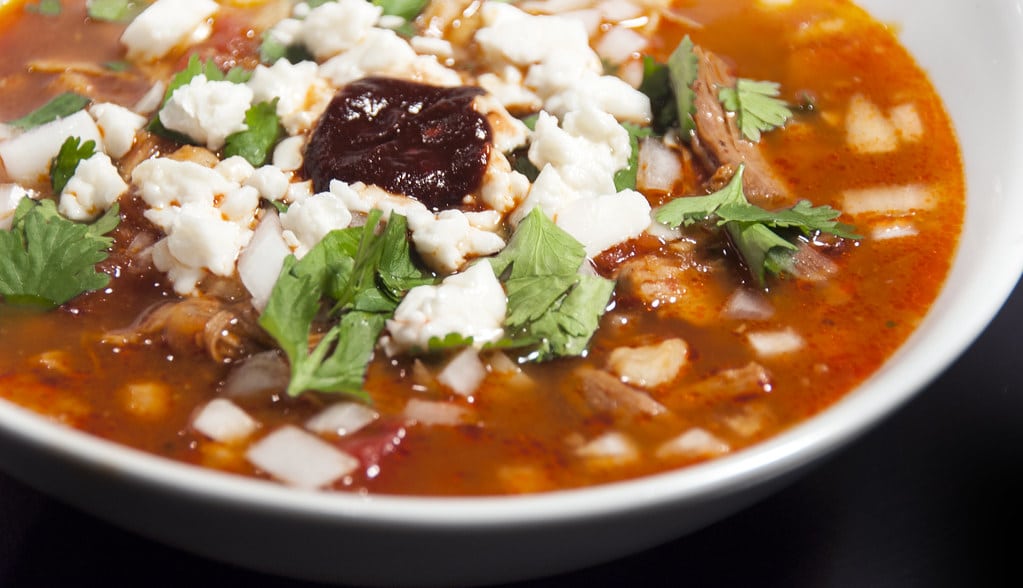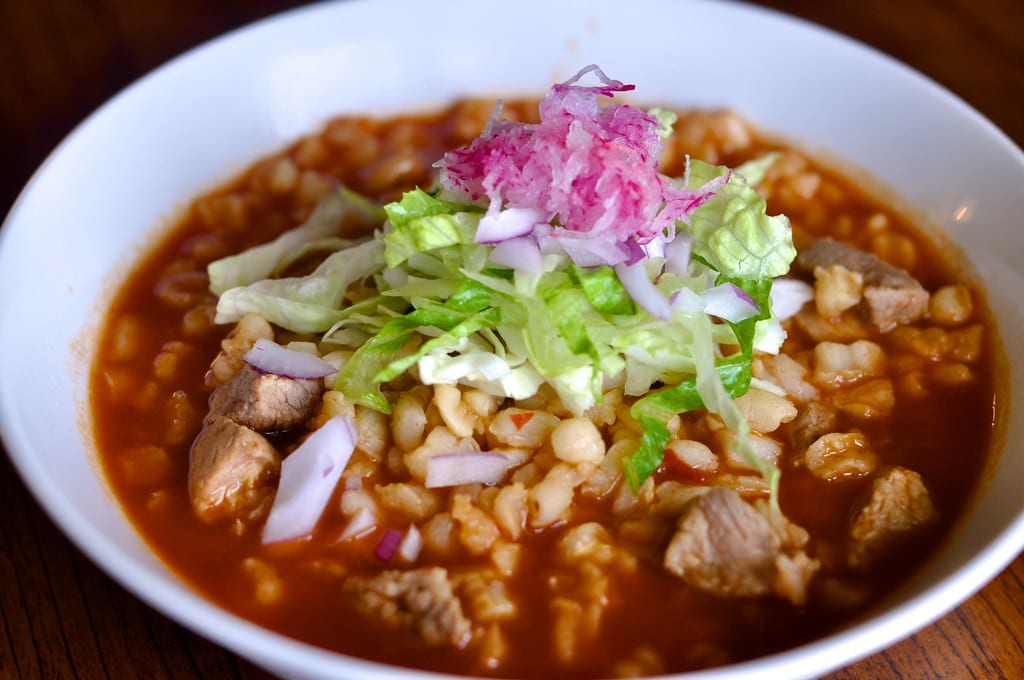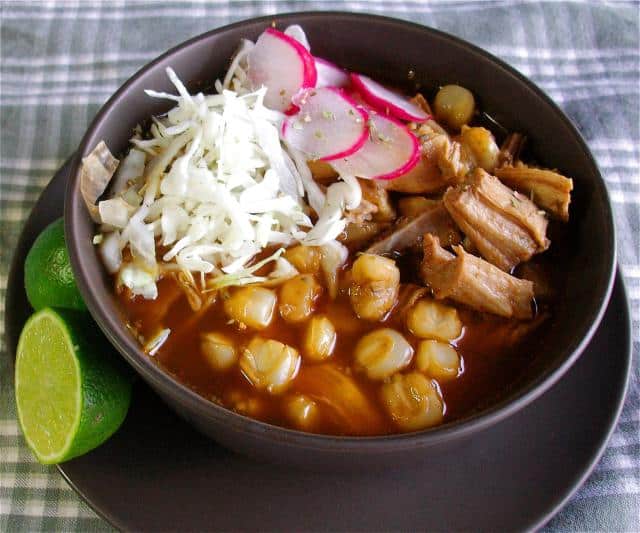Pozole is an ancient dish with roots stretching back to the Aztecs. In those times, pozole was made using a variety of different ingredients, depending on the region in which it was created. Pozole might have included turkey, rabbit, or even human meat! However, over time as cooking techniques improved and access to certain ingredients increased, distinctive variations of this traditional chile-flavored soup began to emerge across various cultures. What makes each variation unique – from Mexico’s red pozole to Guatemala’s white pozole – is what types of meats were originally used by their culture’s ancestors and how those recipes evolved over time. Keep reading for a comprehensive guide about What Was Pozole Originally Made With?
What is pozole?
This traditional Mexican dish has been around since pre-Columbian times, and its origins can be traced back to the Aztecs. Originally, pozole was made with maize (corn) kernels which were boiled in water or broth. The broth would also include chilies, spices, herbs, and other ingredients that varied from region to region. Pork was a popular addition to the stew as well. It is said that pozole was a sacred food of the Aztecs and could only be made for special occasions, such as religious festivals or celebrations of military victories. Today, pozole remains a beloved dish across Mexico and is often served at parties and gatherings. While its primary ingredients have remained largely unchanged throughout the centuries, modern variations of pozole can include a variety of meats, vegetables, and spices.

The history of pozole:
A traditional Mexican dish with ancient origins. The Aztecs made pozole using maize kernels boiled in water or broth, chilies, spices and herbs, as well as pork or other meats depending on the region. It was seen as a sacred food and could only be made for special occasions. Today, it remains an important part of Mexican culture and is served at parties and gatherings across the country, with various ingredients added to suit local tastes and preferences. Whether enjoyed in its original form or modern adaptations, pozole is sure to bring friends and family together around the dinner table.
What was pozole originally made with?
What Was Pozole Originally Made With? Pozole was traditionally made with maize (corn) kernels boiled in water or broth, chilies, spices and herbs, and often pork. This varied from region to region however, as different ingredients were used to create unique flavors and textures. As the dish evolved over the centuries, modern variations of pozole can include a variety of meats, vegetables, and spices. No matter what version you try though, it is sure to be delicious.

What foods are traditionally included in pozole?
Traditional pozole is usually made with maize (corn) kernels that are boiled in water or broth. Other common ingredients include chilies, spices and herbs. Many people also choose to add pork but other meats such as chicken, beef, or even seafood can be used too. Vegetables like onions, garlic, tomatoes and potatoes can also be incorporated for extra flavor and texture. As the dish has evolved over time, modern versions of pozole often feature a variety of unique ingredients.
How to make pozole at home?
Making pozole at home is simple and straightforward. You’ll need to start by gathering your ingredients, which should include maize (corn) kernels, chilies, spices, herbs and the meat of your choice (pork is traditional). In a large pot or Dutch oven, combine the maize with enough water or broth to cover it. Then add in the chilies, spices and herbs and bring the mixture to a boil. Once boiling reduce heat and simmer for around 45 minutes until the maize is tender. Finally add in any extra ingredients like pork or vegetables that you would like included in your pozole. Simmer for an additional 15 -20 minutes and enjoy.
Different regional variations of pozole across latin america:
There are many regional variations of pozole across Latin America. In Mexico, pozole is often served with accompaniments such as avocado, lime wedges, radish slices and tostadas. In Guatemala it is made with both chicken and pork, while in Costa Rica they add red bell pepper and cilantro for extra flavor. In Peru pozole is made using hominy instead of maize kernels and can be either spicy or sweet depending on the region. Regardless of the ingredients used however, pozole remains a beloved dish throughout Latin America.
How to serve pozole?
Pozole can be served hot or cold, although it’s usually enjoyed warm. It’s typically garnished with any combination of onion, garlic, lime wedges, radish slices, tostadas, cilantro and/or avocado. Different regions may have their own unique variations of pozole served with different accompaniments – so be sure to explore the options and find the one that suits your taste!
No matter how you choose to serve pozole, it’s sure to be a delicious addition to any meal. With its ancient roots and modern variations, there is something for everyone when it comes to this beloved Latin American dish.
Tips to make a delicious and authentic pozole:
If you want to make a delicious and authentic pozole, there are a few tips and tricks you should consider. Start with quality ingredients like fresh maize (corn) kernels if possible, as this will ensure the best flavor. To add extra flavor to your pozole, try adding in spices or herbs like oregano, cumin or bay leaves – all of which can be found in most grocery stores. Finally, don’t forget to garnish your dish with accompaniments such as diced onion, lime wedges, chilies and/or avocado – they will take your pozole to the next level. Read more at naanonbroughton.com
How to store leftover pozole?

Leftover pozole can be stored in the refrigerator for up to three days. Make sure it is covered properly and cooled completely before putting it in the fridge. To reheat, just heat it on the stove or in the microwave until warmed through.
Conclusion: What was pozole originally made with?
Pozole is an ancient dish from Latin America that has been around for centuries. was originally made with maize (corn) kernels that were boiled in water or broth, and then flavored with chilies, spices and herbs. Over time, the dish has evolved to include a variety of meats, vegetables and other ingredients depending on regional variations. No matter how it’s served however – hot or cold, with accompaniments or without – pozole remains a beloved dish throughout Latin America. That is What Was Pozole Originally Made With?
FAQ pozole originally made
What is traditional pozole made from?
Pozole is a traditional Mexican dish made with hearty hominy, succulent chicken or pork, and an array of flavorful condiments. From bite to bite you can expect various textures – crunchy lettuce or cabbage; zesty onion and garlic; refreshing radishes as well as avocado for creaminess; spice from chilli peppers brought alive by salsa and limes. All these ingredients come together in perfect harmony making pozole one delicious treat.
Was pozole originally made with human meat?
The ancient Aztec priests offered a unique and chilling ingredient in their pozole stew – the human heart taken from sacrificial offerings to their gods. With Spanish rulers outlawing cannibalism, pork eventually replaced this gruesome ingredient when making pozole. Thus, giving us an enduring dish that is still part of Mexican culture today.
Where was pozole originally made from?
Mexico, a nation on the southern tip of North America with dazzling shorelines and iconic cities such as Cancun has long been hailed for its delicious cuisine. A traditional dish which many Mexicans enjoy is pozole; this hearty stew made with pork or chicken was originated in pre-Hispanic civilizations – it’s still enjoyed today.
Why was pozole originally made?
Pozole, a delicious and popular Mexican dish originating from pre-colonial times, was traditionally served during celebrations honoring the god Xipe Tótec. What made this particular meal unique is that it included an intriguing ingredient – human flesh.
What is the difference between pozole and posole?
Pozole or posole? The answer is simple: the same soup, two different spellings. It all comes down to geography and tradition – depending on where you live in Mexico (or beyond!), one spelling may be more common than another. Whatever spelling you choose, this fiery chili-broth dish will never fail to satisfy your taste buds.
What are the 3 types of pozole?
Pozole, a traditional Mexican soup, comes in many forms – each one as flavorful and exciting as the last! From hearty red to zesty green pozoles, there are countless varities that offer unique flavors for all types of palates. Try something new tonight with Rojo (red), Blanco (white), or Verde (green) pozole – your taste buds will thank you.
Was pozole made with dog meat?
The traditional dish of pozole has a long history, with some reports tracing it back to pre-Hispanic times. Before being made with pork or chicken as we know today, pozole was prepared from the meat sacrificed in religious ceremonies and offered up to their gods – and this could have included Xoloitzcuintle dogs.
Why is pozole so good?
From its aromatic spices to the comforting texture of heirloom corn and succulent meat, it’s no wonder pozole is a Mexican favorite! Enjoy this classic dish for an unforgettable experience that’ll leave your taste buds dancing with delight.
Why is pozole important to Mexican culture?
Pozole serves as a connection to the cultural and spiritual roots of Mexico. Thought to have been first made by the indigenous people, its main ingredient—corn—was sacred in those civilizations for thousands of years before Spanish colonization. Even today pozole has remained an important part of Mexican culture and identity.
What does pozole taste like?
A meal of pozole at La Casa de Toño is a blissful experience – like delving into an array of distinct, bold tastes. The thick red chile broth provides a smoky depth while the corn offers its delicate sweetness. Spice and flavor are all rounded off with bits of succulent pork to create an unforgettable culinary masterpiece.

Bill Dawers is the CEO of naan on broughton, a contemporary Indian restaurant in Savannah, GA. The restaurant opened a few weeks ago and has already found a fan in City Talk columnist Bill Dawers. The restaurant sits right across the street from the Marshall House on Broughton Street, joining the large number of hot spots on the shopping street.

Related Posts:
How Long To Cook Frozen Chicken In A Crock Pot: A Comprehensive Guide
How To Make 3/4 Cup With Measuring Cups? – A Comprehensive Guide
Can you eat Peanut shells? Cracking the Mystery
Does Jasmine Tea Have Caffeine? Learn About Jasmine Tea